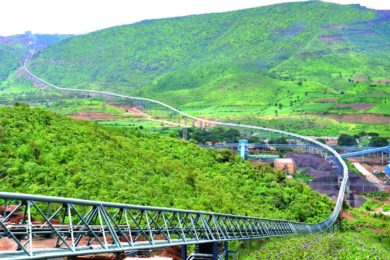Where bulldozers work on ore stockpiles, operators can be exposed to major safety challenges. Poor visibility, unstable ground and material falling from conveyors have led to numerous injuries and fatalities among dozer operators. At BHP Billiton’s Escondida mine in Chile this safety challenge has been addressed by implementing technology to allow dozers to be operated remotely. This protects personnel from the dangers involved in operating dozers within stockpiles, while continuing to provide the benefits to mine operation of using such machinery. Remote Control Technologies (RCT) supplied and fitted five full remote control systems to Cat D11R & D10R dozers and trained the operators.
 A remote controlled bulldozer at Escondida mine in Chile.
A remote controlled bulldozer at Escondida mine in Chile.
Located in the Atacama Desert in Northern Chile, Minera Escondida produces copper from two open-pit mines, one at Escondida and the other 5 km away at Escondida Norte. BHP Billiton holds a 57.5% interest in Minera Escondida. Annually, the mine moves some 400 Mt of material to ensure a continuous flow of ore to its concentrators at Laguna Seca and Los Colorados, oxide and sulphide leaching facilities. Three stockpiles support ore feed to the plants with dozers used to move material within these stockpiles to ensure a continuous supply of feedstock to the plants. Using dozers within stockpiles has strong positive impacts on plant performance by eliminating prolonged interruption to feedstock supply and so maximising the volume of ore processed and economic benefits from that processing.
During 2006, the global mining industry experienced several fatal accidents involving dozers operating on stockpiles. Between 2001 and 2006, there were several incidents involving dozers on the Escondida stockpiles. In an incident in March 2006, where the operator eventually escaped with minor injuries, one of its dozers was buried for five hours.
Escondida’s challenge was to develop an approach that allowed it to continue to gain the economic benefits of operating dozers within stockpiles while reducing risk to the safety of the operators. Analysis showed that the only sure way of addressing such risk was to remove the dozer operators from their cabs. They needed to be able to operate their machines from a safe, remote, location. The steps to achieving remote operation included:
- Evaluating past accidents
- Working with companies that supply remote operation technology
- Undertaking pilot tests
- Training the operators to use remote control equipment
- Implementing the new operating method
The project involved adapting state-of-the-art technology used in other mining processes and applying it to bulldozers operating within ore stockpiles. Challenges included sourcing the best equipment for the task, ensuring it was appropriate to Escondida’s conditions and operation and that it could be adapted effectively, and then training the operators in a new way of working.
Escondida undertook the first site test and completed equipment installation in early 2007 and, after operator training, began full operation in mid 2007. The remote control dozers have performed well, assisting in maintaining operational continuity and improving safety.
Implementing remote operation for dozers within ore stockpiles at Escondida shows there is potential to apply this technology in other operations where operating a dozer involves a safety risk to the operator. Potential situations where the technology could be used include operations on unstable or soggy ground, or on drilling platforms with limited access.








